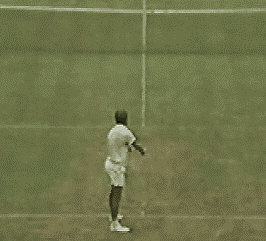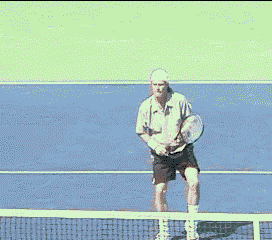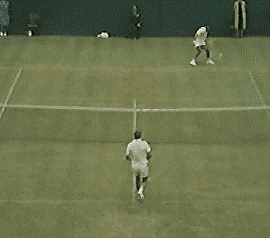| TennisOne Lessons Then and Now Examining past and present strokes and strategies Dave Smith TennisOne Senior Editor Examining tennis from a generation or two ago can seem like going back to the dark ages in some respects. However, in other respects, parts of tennis have changed very little. Why has tennis changed almost violently in some regards while other parts have remained nearly unchanged?
Using some video clips of Lew Hoad playing a pioneer in the two-handed backhand, El Shafei, we can examine both subtle as well as significant changes in the modern game. I vaguely remember this rule change when I was starting to play seriously in my freshman year in high school. Oddly enough, at the time, I remember this as the "Arthur Ashe Rule."
Watch the first video clip above and you will see the front foot of Lew Hoad staying on the ground until after contact. This promoted the ‘step through’ footwork pattern on the serve up to that time. Because a foot had to stay on the ground—and the predominant strategy of the day was serve and volley—players began their approach during the serve with the back foot sweeping around the front foot that was staying in contact with the ground. This footwork pattern on the serve made it difficult for many recreational players to learn spin serves emulating this technique. The reason was that when beginners step through with their back foot early like the pros did in that day-and-age, they tended to open up the hips and shoulder plane early. We see this today among beginners and among many who are taught to step through. When the top players did it, they would hold back their rotation allowing the racquet to accelerate and apply the correct spin. A player who is too open can’t hit a proper slice or topspin serve into the court. Even today, we see many recreational players invariably open up too early and can only hit relatively flat serves - the only way to direct the ball into the court from this position. Which is why you often see these players bunt their second serves. Without significant spin, they must rely on gravity to bring their ball down into the court.
There is a belief held by a few old-timers that by stepping through, a player will be one step further into the court than if they pushed off and landed on the front foot as we see today’s players predominantly do. However, this is not true. Because the back foot can’t make contact with the ground in front of the baseline before contact of the ball is made, this foot is generally no more in front than a player’s front foot at contact with the ball while in the air. When a player lands on this front foot, they are essentially just as far into the court (or further) as a player who is stepping through with the back foot. The big advantage in landing on the front foot is the inertia of the body rotating during contact carries the body forward onto the back foot, a good two or three feet in front of the front foot that landed first and anywhere between four and six feet inside the baseline immediately following this contact phase.
Players who swing the back foot forward and land on this foot have fully rotated and actually have to change their inertia in the opposite direction to get their weight moving forward towards the net. Notice that the predominant grip for almost all the strokes was the continental. The preponderance of slice in the game coupled with an overall flatter drive on both wings dictated the grips. Surprisingly, aggressive footwork was not as much of a staple during this era. It almost resembles a ‘cat and mouse’ game where players seemed to taunt and tease their opponents. You can see why there were fewer unforced errors in this era, too. Players took fewer chances and maintained a ‘make them hit the ball one more time’ mentality. This is the game that I learned growing up in the 70’s.
Today’s game, in comparison, could almost be labeled ‘violent’ or ‘brutal.’ It isn’t any wonder that very few players can sustain a career in today’s tennis arena without some serious injury. Certainly, Roger Federer’s game has some sense of fluidity that could be reminiscent of Hoad’s generation. Yet, he also possesses firepower that I doubt would have been thought possible a few decades ago. Ironically, Hoad was not known for his patience in his early years. Considered by many to be the strongest man to play tennis in that era, Hoad often blistered the ball, relatively speaking, hitting early for winners in somewhat of a flamboyant manner. However, when Hoad was on, he was considered one of the most prolific players in the game. He won 13 major titles and even reached the finals of the South African doubles championship in 1973 at the age of 39. The Australian’s bad back cut his singles career short. He took his last title in 1957.
Conclusion Of course, some traditionalists might argue that the changes in today’s game have diminished some level of enjoyment. They pine for the days when the game was played mostly on grass and players like Hoad came to the net at every opportunity. I equate it to race cars; Imagine the disbelief of seeing a Formula One race car of today racing in the early 1920’s or even the 1960’s! Now imagine seeing the 145 mph serve of Roddick or a James Blake forehand in Hoad’s era or before!
Kind of scary, isn’t it? You think that players might have been a little more cautious when strolling up to the net? Your comments are welcome. Let us know what you think about Dave Smith's article by emailing us here at TennisOne .
TENNIS MASTERYFinally. a resource that unlocks these mysteries: • Why do m • Why are making changes in one's game so frustratingly difficult? • What tennis teaching methods are disruptive or detrimental to player progression? Read David W. Smith's TENNIS MASTERY and learn not just how to avoid playing at mediocre levels, but how the best players in the world Master the sport of tennis! "With a depth of knowledge and fresh perspective, TENNIS MASTERY is set to become a manual for tennis instructors and a measure for tennis literature." Richard Wigley, Director, Kayenta Tennis Center, Ivins Utah. Take in David Smith's 30 plus years in the tennis teaching industry. This 335-page manual will provide for every level of player as well as support for all tennis-teaching professionals, a blueprint for reaching higher levels of tennis mastery. Order TENNIS MASTERY at tenniswarehouse.com , or go to tennismastery.net for exciting excerpts from the book and a host of tennis information! And check out David Smith's other articles found here at TennisONE.com Learn more from Dave Smith at his Desert Shadows Tennis Institute!
Next available DSTI camps are November 28th - 30th and December 5th - 7th! Space is limited! Call (435) 628-5000 and ask for the tennis pro shop to learn more about Desert Shadows Tennis Institute. Learn the Advanced Foundation, discover tools to master more advanced techniques for all strokes, and discover that staying at the same level you are is NOT AN OPTION! A select number of camps are available but space is very limited. The DSTI camps take place in St. George, Utah, in the heart of ‘Color Country’—the incredible beauty of Southern Utah. Zion, Bryce Canyon and Grand Canyon National Parks are all nearby! Hurry to reserve your spot now for a true ‘tennis destination’ opportunity! “The most informative, intuitive tennis camp I have ever attended.” Randy S. Colorado “Dave and his staff have a passion for the game and a personal care for their students.” S. Loo, Nevada “The depth of instruction is far superior to that of other tennis camps I’ve been.” Tom T. Nevada |





 illions of tennis players stagnate at levels far below their potential?
illions of tennis players stagnate at levels far below their potential?  Join Dave Smith in an intimate, ultimate tennis camp: Desert Shadows Tennis Institute (DSTI) is an intense, 3-day camp that accepts only 12 players to work directly with Dave and his staff of certified and accomplished pros. Over 18 hours of tennis instruction is included along with a copy of Dave’s best-selling tennis book, TENNIS MASTERY, a DVD of instruction, breakfast and lunch each day, and a lifetime of tennis secrets!
Join Dave Smith in an intimate, ultimate tennis camp: Desert Shadows Tennis Institute (DSTI) is an intense, 3-day camp that accepts only 12 players to work directly with Dave and his staff of certified and accomplished pros. Over 18 hours of tennis instruction is included along with a copy of Dave’s best-selling tennis book, TENNIS MASTERY, a DVD of instruction, breakfast and lunch each day, and a lifetime of tennis secrets!